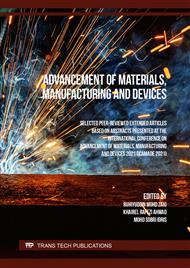[1]
Ates, M. (2016). A review on conducting polymer coatings for corrosion protection. Journal of Adhesion Science and Technology, 30(14), 1510–1536.
DOI: 10.1080/01694243.2016.1150662
Google Scholar
[2]
Tang, Z. (2019). A review of corrosion inhibitors for rust preventative fluids. Current Opinion in Solid State and Materials Science, 23(4), 100759.
DOI: 10.1016/j.cossms.2019.06.003
Google Scholar
[3]
Shekari, E., Khan, F., & Ahmed, S. (2017). Economic risk analysis of pitting corrosion in process facilities. International Journal of Pressure Vessels and Piping, 157, 51–62.
DOI: 10.1016/j.ijpvp.2017.08.005
Google Scholar
[4]
Khan, M. S., Kakar, F. K., Khan, S., & Athar, S. O. (2018). Efficiency and Cost Analysis of Power Sources in Impressed Current Cathodic Protection System for Corrosion Prevention in Buried Pipelines of Balochistan, Pakistan. IOP Conference Series: Materials Science and Engineering, 414(1).
DOI: 10.1088/1757-899x/414/1/012034
Google Scholar
[5]
Tian, W., Du, N., Li, S., Chen, S., & Wu, Q. (2014). Metastable pitting corrosion of 304 stainless steel in 3.5% NaCl solution. Corrosion Science, 85, 372–379.
DOI: 10.1016/j.corsci.2014.04.033
Google Scholar
[6]
Mathiazhagan, A. (2010). Design and Programming of Cathodic Protection for SHIPS. International Journal of Chemical Engineering and Applications, 1(3), 217–221.
DOI: 10.7763/ijcea.2010.v1.36
Google Scholar
[7]
Qian, S., & Cheng, Y. F. (2017). Accelerated corrosion of pipeline steel and reduced cathodic protection effectiveness under direct current interference. Construction and Building Materials, 148, 675–685.
DOI: 10.1016/j.conbuildmat.2017.05.024
Google Scholar
[8]
Wang, F., Xu, J., Xu, Y., Jiang, L., & Ma, G. (2020). A comparative investigation on cathodic protections of three sacrificial anodes on chloride-contaminated reinforced concrete. Construction and Building Materials, 246, 1–10.
DOI: 10.1016/j.conbuildmat.2020.118476
Google Scholar
[9]
Song, Y., Shan, D., & Han, E. H. (2017). Pitting corrosion of a Rare Earth Mg alloy GW93. Journal of Materials Science and Technology, 33(9), 954–960.
DOI: 10.1016/j.jmst.2017.01.014
Google Scholar
[10]
Salleh, S.H., Jantan, W.E., Malek, R.A., Abdullah, S.S.C., Balan, P. (2021). The hydrogen evolution of pure magnesium in different electrolytes. AIP Conference Proceedings 1 (2339), 020238.
DOI: 10.1063/5.0044518
Google Scholar
[11]
Su, Y., Li, G., & Lian, J. (2012). A chemical conversion hydroxyapatite coating on AZ60 magnesium alloy and its electrochemical corrosion behaviour. International Journal of Electrochemical Science, 7(11), 11497–11511.
Google Scholar
[12]
Yang, Y., Scenini, F., & Curioni, M. (2016). A study on magnesium corrosion by real-time imaging and electrochemical methods: Relationship between local processes and hydrogen evolution. Electrochimica Acta, 198, 174–184.
DOI: 10.1016/j.electacta.2016.03.043
Google Scholar
[13]
Sherif, E. M. (2012). Corrosion Behavior of Magnesium in Naturally Aerated Stagnant Seawater and 3.5 % Sodium Chloride Solutions, 7, 4235–4249.
Google Scholar
[14]
Contreras Davila, G., Gomez-Quinones, J. I., Perez-Gonzalez, V. H., & Martinez-Duarte, R. (2016). Assessing the Advantages of Using Square Wave Signals for Particle Trapping in Carbon-Electrode Dielectrophoresis. ECS Transactions, 72(1), 105–114.
DOI: 10.1149/07201.0105ecst
Google Scholar



